 |
Recently I've been designing some analog circuitry very sensitive to the ripple of the supply rails. The low frequency ripple was suppressed by the regulators and operational amplifiers had enough power supply rejection ratio (PSRR) so the effect was low enough. However I had some nasty resonances at frequencies around 10 to 100 kHz reaching up to over 0.5 mV due to parasitic inductance of the PCB. So I was looking for some very low ESR decoupling capacitors because 10 µF ceramics I used are effective from few hundred kHz. So I bought various polymer capacitors that seemed to have good paper parameters and verified that by measurement. I also measured several other caps in the lab. Following graphs show the results. All the measurements are made at 23 °C. Frequency range was limited by the Keysight E4980A up to 2 MHz but except one of the caps it was enough to catch the resonance. Uncertainty of the measurements at the lowest impedance is some 2 mΩ due to the used adaptor.
| Type | Brand | Model | Value |
|---|---|---|---|
| ceramic | MURATA | GCM32ER71E106KA57L | 10 µF/25 V |
| electrolyte | PANASONIC | EEUTP1E821 | 820 µF/25 V |
| tantalum-polymer | AVX | TCJD336M025R0060 | 33 µF/25 V |
| polymer | X-CON | ULR187M1CF1ARRX0CR | 180 µF/16 V |
| SAMWHA | FA1C157M10079VR | 220 µF/16 V | |
| Elite | UPE1E181MNN0811 | 180 µF/25 V | |
| UPE1C821MNN1012 | 820 µF/16 V | ||
| KEMET | A750EK476M1EAAE040 | 47 µF/25 V | |
| A750EK227M1CAAE016 | 220 µF/16 V | ||
| A750KK477M1AAAE016 | 470 µF/10 V | ||
| A750MS567M1EAAE015 | 560 µF/25 V | ||
| A750MS827M1CAAE013 | 820 µF/16 V |
First one tested is my favourite SMD ceramic in 1210 package, 10 µF/25V X7R. I often put these as decoupling to analogue instead of tantalums. As it is quite clear from the graph it has very low impedance but it's most effective somewhere around 1 MHz. The X7R's are not that brutally dependent on bias voltage as the Y5V so it seems to be a good choice. The measurement was made also by Wayne-Kerr 6530A bridge but I had a bit of a problem with load corrections (refence standards) in dimensions similar to the DUT, so the series inductance, ESR and of course resonance are not very accurate to low frequency measurement. Uncertainty around the minimum is some 4 mΩ.
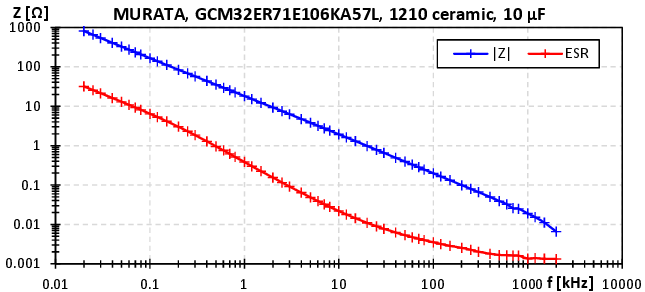 Fig. 1.1 - MURATA, GCM32ER71E106KA57L, ceramic, SMT 1210, 10 µF, 25 V. Measured at 50 mA and bias 10 V. Resonance is somewhere at 1.5 to 2.5 MHz.
|
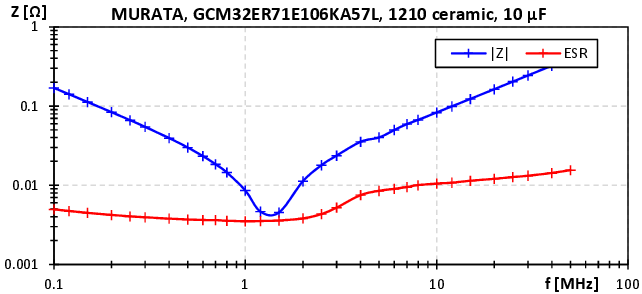 Fig. 1.2 - MURATA, GCM32ER71E106KA57L, ceramic, SMT 1210, 10 µF, 25 V. Measured at 10 mA and no bias. Resonance is somewhere at 1.5 to 2.5 MHz.
|
Next one is some better low ESR 820 µF/25V electrolyte from Panasonic. Marking says 135 °C which is kind of unusual and it was pretty expensive. But it has very nice and wide range of low Z exactly where I needed.
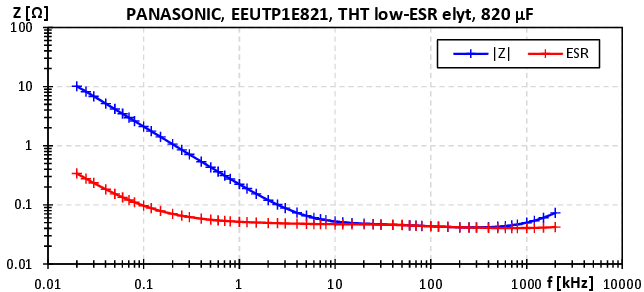 Fig. 1.3 - PANASONIC, EEUTP1E821, aluminium electrolyte, THT D10x25 mm, 820 µF, 25 V. Measured at 50 mA and bias 10 V. Resonance is somewhere at 100 kHz.
|
Next I bough some 33 µF SMD polymer-tantalum from AVX. I never tried these before but it seems to do what it should. Datasheet says 60 mΩ ESR, 40 mΩ measured.
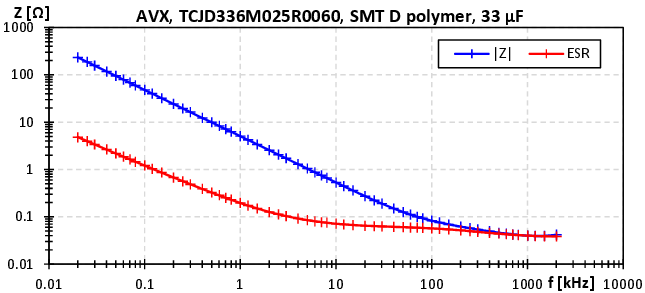 Fig. 1.4 - AVX, TCJD336M025R0060, tantalum-polymer, SMD size D, 33 µF, 25 V. Measured at 50 mA and bias 10 V. Resonance is somewhere at 1 MHz.
|
Next I tested bunch of polymer caps of different brands. All of them are surprisingly light and also quite cheap and all safely meets datasheet values. These seems to be optimal for my use. First one is very cheap 180 µF/16 V from X-CON (0.3 $). Datasheet claims 13 mΩ, I measured some 10 mΩ. Apart from significantly lower capacitance it seems to be ok (150 µF entire bunch).
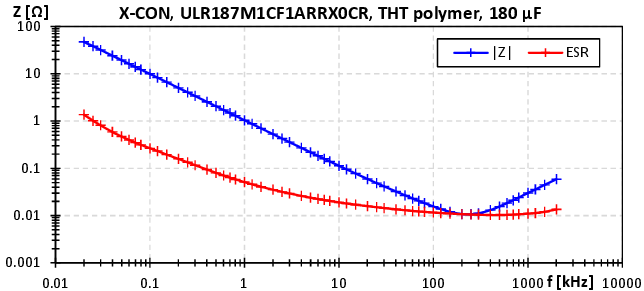 Fig. 1.5 - X-CON, ULR187M1CF1ARRX0CR, polymer, THT D8x11.5 mm, 180 µF, 16 V. Measured at 50 mA and bias 10 V. Resonance is somewhere at 220 kHz.
|
Another one is 220 µF/16 V from KEMET and it is even smaller. Datasheet claims 14 mΩ, I measured 10 mΩ. Price was a bit higher (0.35 $).
 Fig. 1.6 - KEMET, A750EK227M1CAAE016, polymer, THT D6.3x8 mm, 220 µF, 16 V. Measured at 50 mA and bias 10 V. Resonance is somewhere at 180 kHz.
|
Last one is SMD 150 µF/16 V from SAMWHA. A bit bigger, datasheet claims 30 mΩ, measured 12 mΩ which is not bad. Price was only 0.2 $.
 Fig. 1.7 - SAMWHA, FA1C157M10079VR, polymer, SMD D10x8 mm, 220 µF, 16 V. Measured at 50 mA and bias 10 V. Resonance is somewhere at 260 kHz.
|
Update 10.2.2017: I needed some higher capacitance and higher voltage types so I bought next bunch of capacitors. First one is THT 560 µF/25 V from Kemet. Claims ESR 15 mΩ, measured less than 8 mΩ. Price is less than 0.7 $. Resonance is still quite high despite the capacitance.
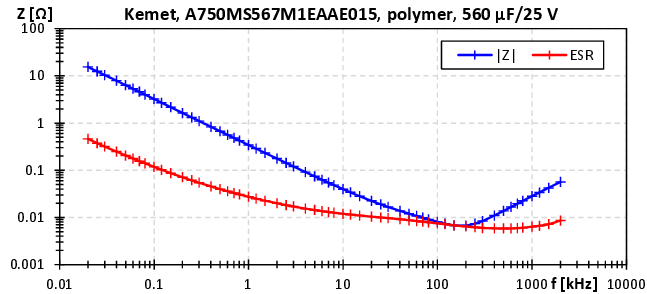 Fig. 1.8 - KEMET, A750MS567M1EAAE015, polymer, THT D10x12 mm, 560 µF, 25 V. Measured at 50 mA and bias 10 V. Resonance is somewhere at 180 kHz.
|
Next one is some small THT 47 µF/25 V also from Kemet. Claims ESR 40 mΩ, but measured less than 10 mΩ so I wonder why that pessimistic datasheet value. Price is 0.3 $. Resonance is quite high but the usable range of low impedance is a bit too narrow.
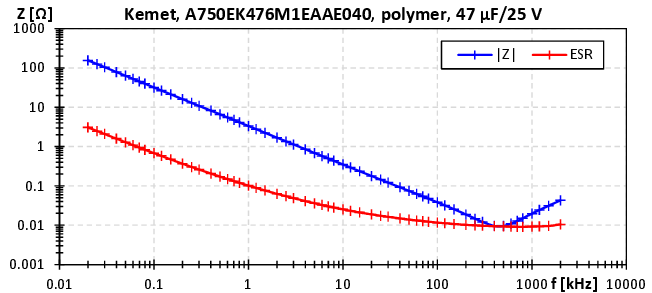 Fig. 1.9 - KEMET, A750EK476M1EAAE040, polymer, THT D6x8 mm, 47 µF, 25 V. Measured at 50 mA and bias 10 V. Resonance is somewhere at 450 kHz.
|
Next cap is 180 µF/25 V from Elite. Claims ESR 16 mΩ, but measured about 24 mΩ so finally some that does not fit the datasheet values. :-) Price is 0.3 $. Due to high ESR it has wide constant low impedance region.
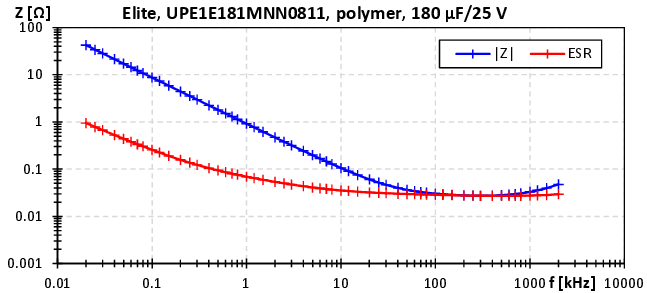 Fig. 1.10 - Elite, UPE1E181MNN0811, polymer, THT D8x11 mm, 180 µF, 25 V. Measured at 50 mA and bias 10 V. Resonance is somewhere at 250 kHz.
|
Last one for this batch is 820 µF/16 V also from Elite. Claims ESR 12 mΩ, measured about 9 mΩ. Price is 0.35 $ so it's a cheapie. Despite the capacitance it still resonates above 100 kHz.
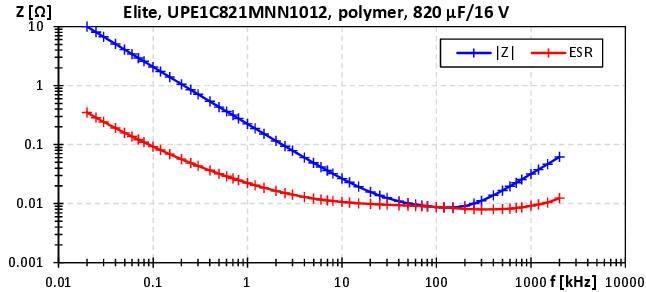 Fig. 1.11 - Elite, UPE1C821MNN1012, polymer, THT D10x12 mm, 820 µF, 16 V. Measured at 50 mA and bias 10 V. Resonance is somewhere around 100 kHz.
|
Update 20.4.2017: I needed few more caps so here is another batch. First one is THT 820 µuF/16 V from Kemet. Datasheet ESR is 13 mΩ, measured below 6 mΩ. Price 0.6 $. Resonance is above 100 kHz.
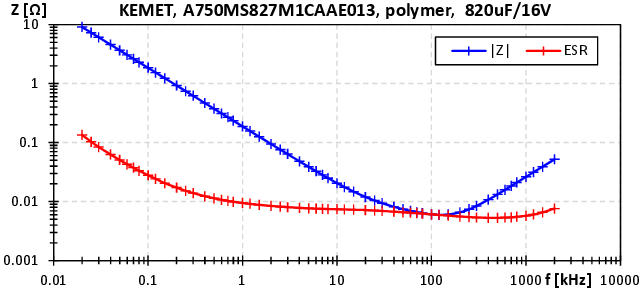 Fig. 1.12 - KEMET, A750MS827M1CAAE013, polymer, THT D10x12 mm, 820 µF, 16 V. Measured with AC current 100 mA and DC bias 10 V. Resonance is roughly 110 kHz.
|
Next one is 470 µF/10 V from Kemet. Datasheet says ESR 16 mΩ, measured some 7 mΩ and it is a cheap one (0.4 $). Resonance is around 180 kHz. Same as the previous one it has nice flat ESR.
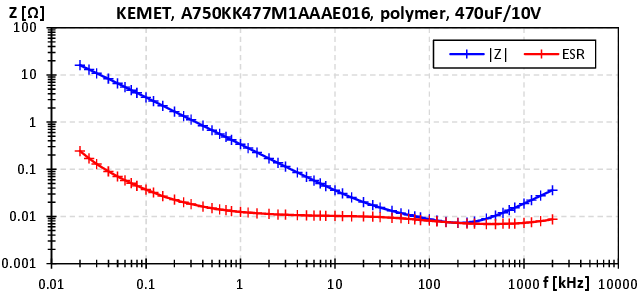 Fig. 1.13 - KEMET, A750KK477M1AAAE016, polymer, THT D8x8 mm, 470 µF, 10 V. Measured with AC current 100 mA and DC bias 8 V. Resonance is roughly 180 kHz.
|
I have no idea how these capacitors behave at high temperature or high AC current and what will be the lifespan. However for purposes of decoupling analogue circuits at reasonable temperatures it seems perfectly fine. Especially assuming the price.
| Last update: 21.1.2017 |  |
 |